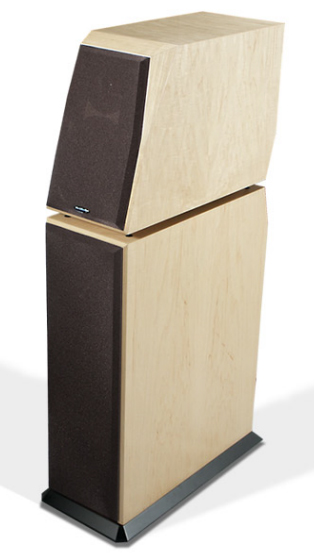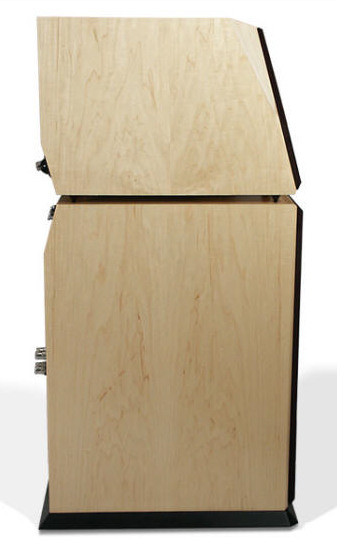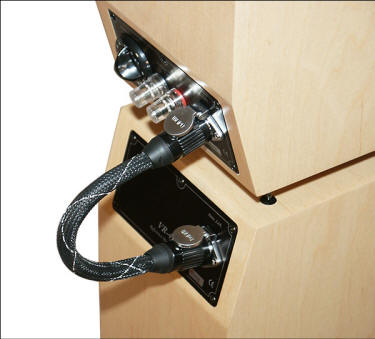
You are reading the older HTML site
Positive Feedback ISSUE
may/june 2007
von schweikert
VR-4JR MkII loudspeakers - A Speaker of Many Virtues
as reviewed by John Zurek

|
JOHN ZUREK'S SYSTEM
LOUDSPEAKERS
ELECTRONICS
SOURCES
CABLES
ACCESSORIES
OFFICE SYSTEM
|
It started out innocently enough. One of the spikes broke—my fault—on my 24-month old Von Schweikert VR-4JRs. A speaker with three spikes sounds dire, and it is sure not level. What to do? Maybe get some of those upscale, very expensive spikes that claim to fix every problem, you've ever had with your system? Hmm...my tax return was staring at me from the table. "Be frugal" I heard. I decided to ring up Von Schweikert Audio. Maybe they'd let me buy one spike—only one. I was surprised when I got to speak to Albert Von Schweikert himself. What a nice guy. After we discussed my spike problem, he said, "Did you know we've upgraded the VR-4JR to the MkII version"? "No", I said. "Can you retrofit the current version?" "Absolutely." I was hooked. We set up the review in the minutes that followed.
Think back a few years. The original VR-4JR MkII was generating quite a buzz in the audiophile community. A nearly full-range floor-standing transducer from Von Schweikert, perfect for mid-sized rooms, it was dubbed an overachiever by just about everyone who heard it. I was in the market for new speakers at the time. This very affordable transducer shot to the top of my short list.
After listening to the JRs at a couple of shows and a dealer demo, I was sold. I bought them, enjoyed the hell out of them, and never looked back. Not perfect, but the price-to-performance ratio was almost impossible to beat. BTW, JR stands for just right, not junior.
Now that I'd committed to the upgrade, I was going to be without my main speakers for a few weeks. I began what I thought was going to be a grueling process of getting the speakers ready for shipment. Thoughts of packing and shipping all the other speakers I've owned came back, never a fun job. I'd only unpacked the JRs, and it was quite a while ago. I went out to the garage to retrieve the boxes from their upper storage shelf. They've been up there for almost two years. Wrestling them down, I'm thinking, "These are too heavy—I must have put something else inside". Finally getting them into my listening room, and inspecting, I find nothing but box …and ...ahh, the wooden crates inside the boxes—it's coming back. Von Schweikert packs their speakers in heavy-duty plywood crates that protect them for life.
I'd also forgotten about the excellent ergonomics of the entire system that Von Schweikert designed for packing and shipping these speakers. System? Yes, it is an ingenious system, designed to make it easy to pack and ship your precious speakers. First, a cool velvet bag with drawstrings for the both the mid/high module and the bass module lets you move each section around without fear of scratching. Next, open the sarcophagus-like crate. Inside are precision tailored enclosures with heavy-duty foam rubber inserts. Also included are straps that let you lower (or raise) each module from the crate. After tucking the speakers in, position the foam inserts for a perfect fit, and sleep well knowing your speakers will survive anything big brown can throw at them. This system actually facilitates packing your speakers by yourself. Even so, I suggest getting a friend to help, but—if you have to—you can take a little extra time, and prepare them for shipping by your lonesome. I know of very few companies who care enough to take the time to design such an outstanding pack/ship system. Obviously, Von Schweikert cares.

For those not familiar with the JRs, we're talking a dynamic-driver four-way system using a triple-chambered transmission line and two-piece stacking enclosure. Its frequency response is 23-20 kHz, +/- 2 dB, 20 Hz-25 kHz -6 dB, (+/- 1dB at midband) with 6 ohms average impedance, and recommended power of 20 watts up to 300 watts. Considering those numbers and its 89 dB sensitivity, it is easy to drive.
More from the Von Schweikert website: The triple-chambered transmission line is a hybrid design composed of three separate chambers coupled to the room by a tuned vent at 25Hz. A one-inch thick front baffle provides exceptional vibration control and image solidity, while one-inch MDF fiberboard interlocking braces provide exceptional rigidity and freedom from boxy colorations. The internal damping consists of thick acoustic felt lining and Dacron stuffing to eliminate cavity resonances. Large carpet spikes are provided.
Drivers include 2-7" mica-cellulose poly-laminate woofers, 1-7" carbon mica-cellulose poly-laminate midrange driver, 1-1" poly-tri-laminate silk-dome tweeter, 1-1" rear firing ambience mid/tweeter with fabric dome and transmission-line loading. The crossover is acoustic fourth order, at 200Hz and 2.2kHz, optimized for flat off-axis response and phase consistency over a wide global axis. Film-foil capacitors and custom air-core inductors are used that can handle up to 1500 watts before saturation, with computer-optimized internal wire.

You might ask yourself, "What's new in the MkII?" New woofers, new internal woofer-chamber damping materials, 20 pounds of factory-installed sand (no more lead shot to install—what a chore that was), improved internal damping of the upper midrange module, new sonically "invisible" active circuit protection system against voice coil failure and/or burnout, improvements, changes, and refinements in the crossover, and new spikes.
Be prepared for the long, long, break-in period, 400-500 hours. Ouch! I set my CD player for random repeat, and poked my head in every few days to change disks. Finally, after three weeks of listening to my headphone system, I decided they had to be ready.
First impressions? Very favorable, especially the mids. Tonal balance seemed more natural and neutral. The clean, liquid openness the midrange developed was inspiring. Silkier highs combined with a much more controlled bass were immediately obvious. If I had to describe the upgrade in one word, it would be refined. Refined in every sense, the MkII is now like a young prodigy that has come into its own. If you are a MkI owner, you'll notice (after break-in) that the MkII is bit different in overall feel, more neutral, more balanced, and more sophisticated. The Mk Is occasional puddingy bass has been banished, replaced with articulate low notes. That mid-range haze wiped clean, transparency in its place. I could not believe this was the same driver. I called VSA to ask Albert if they replaced the mid-range driver, he said, "no—the enhanced performance was all due to the improved internal damping of the upper midrange module".
In my room (and I suspect yours) the setup should be easy. Place them wide apart, and toe them in. You will be instantly rewarded. They sounded best not completely toed-in, but when a little reflection on the inner sides of the cabinet was visible.
The MkII is a highly resolving speaker with incredible focus. It allows you to see far into the recording, sounding equally accurate at low and high volumes. The overall presentation is now more open and dramatic, with a soundstage that won't quit.
Although it has a character, as all speakers do, the MkII is true to the music. Dynamics, especially micro are now reproduced with more precision. This precision increases as you refine the positioning of the speakers in your room. I found the MkII more robust than the original, and although I did not measure it, my impression was that it is able to play a bit louder and still maintain quality.
On many recordings, the MkIIs had the ability to disappear, although on some albums they tended to localize right and left to the speaker itself. Images are stable and delineated, and low-level detail is superior to the Mk I. The MkII produced a 3-d space in a deep, wide stage. The soundstage can be massive if it present in the recording. This speaker will reward you, especially if you take care to feed it with quality upstream components. The reduction of noise between instruments and voices was evident.
You should bi-wire this speaker to get full performance. Use a separate run to both the upper and lower modules. Using the Data Link connector degrades the sound. Be careful with the rear-firing adjustable tweeter. Too much volume may produce an over-focused, over-detailed presentation. Its behavior in your room will of course be different. I used it at level one or less, just to get that morsel of ambience I believe it's meant to provide.
When I listened to "November 99" from Manu Katche's Neighbourhood, I was immediately struck by the way the MkIIs rendered this tune vs the MkIs. An excellent Manfred Eicher recording from ECM, the sound was pleasant enough with the MkIs, but this? Now, the instruments just hung there in their own individual spaces. Slawomir Kurkiewicz's double bass purred and Manu's drums had mapley resonance, and that instant thunder that comes from hitting hard quickly. This was a different, much more vibrant recording; each instrument was succinctly placed in its own uncluttered space. Scale was almost 1:1. Outstanding.
On "Language" from Mike Stern's Who Let the Cats Out, Richard Bona's voice and Mike's guitar doubling the opening statement were presented in delicate uniformity. I could hear each independently, and both together, depending on which I cared to concentrate on. The background voices were arranged in successive multiple layers from front to back through the depth of the soundstage, with Kim Thompson's dry ride cymbal furthest back, right where it belongs.
The silky string textures in the "Molto Addagio" of the Miami String Quartet's version of the Saint-Saens Op 153 were absolutely addicting. Every nuance of interplay was vividly portrayed. Warm and subtle, pure grace and emotion flowed out of the speakers. I was in string quartet heaven. You expect this magic from a reference grade component.
The VR-4JR Mk I, although not perfect, was a significant achievement in price-to-performance ratio. The MkII, although more expensive, widens that ratio. VSA now dubs the VR-4JR MkII "the Virtue". Virtuous indeed. The MkII is a nearly full-range, transparent, dynamic, and detailed speaker. It is able to play loud at a single bound when required, and very, very close to reference-quality when properly fed and cared for. You can drive it with a wide variety of amplifiers, and it's perfect for medium-sized rooms. The ten-year warranty doesn't hurt either. This upgrade transforms the JR from a really, really good speaker to a great speaker. My JR is all grown-up now, the upgrade breathed in maturity and passion.
The original VR-4JR was and still is an outstanding value. All you MkI owners who want step up to a much higher level of performance and enjoyment can do so for a paltry $990. Is it worth it? Absolutely. For what you gain in performance, the upgrade is a bargain. Buying a new speaker? The virtuous MkII now sells for $5695. I can enthusiastically recommend the Virtue. Upgrade, or buy ‘em new, either way, you can't loose. John Zurek
VR-4JR MkII
Retail: $5695
Von
Schweikert Audio
web address:
www.vonschweikert.com
